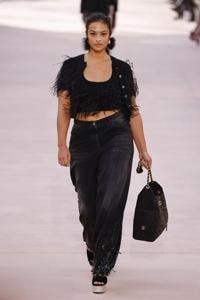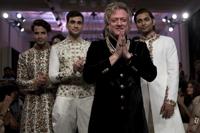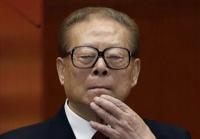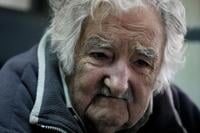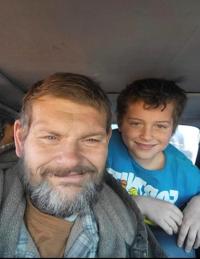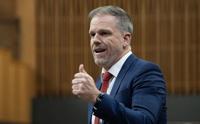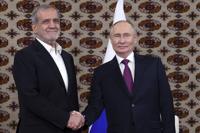PARIS (AP) — A giant empty cage greeted Chanel’s guests at its return to the Grand Palais on Tuesday. Though perhaps not intentionally symbolic, the décor seemed to capture the current state of the house itself: a majestic structure empty of creative direction. With Virginie Viard’s recent departure, Chanel finds itself at a crossroads, as the fashion world eagerly awaits the appointment of a new creative leader.
Meanwhile, in a powerful step toward embracing diversity, Chanel announced as its newest ambassador. The appointment of the Oscar-winning actor, who is Kenyan Mexican, comes at a pivotal moment for the French fashion house that had faced criticism in the past for its lack of inclusivity. This move follows the widely-lauded appointment of British-Indian Leena Nair as Chanel’s global chief executive in 2022, making her the only woman of color at the helm of a major luxury brand.
Here are some highlights of spring-summer ready-to-wear shows:
Chanel: seeking a vision beyond the emp
ty cage
The spring collection delivered many familiar elements from Chanel’s vast repertoire — chiffon capes, slit skirts, embroidered transparent shirt dresses, trench coats adorned with multicolored feather prints, aviator jackets with Peter Pan collars, total pink or blue tweed looks, and the iconic little black dress that Chanel herself introduced to the world. Tweed, jersey, faille, transparent embroidery, sequins, fringe, pastel knits, and sparkling platform shoes all made an appearance, forming a showcase of the house’s signatures.
Yet despite the breadth and richness of the offering, something was amiss. There was little cohesion, and at times, the collection lacked the unmistakable soul that once characterized Chanel’s shows. A series of foulard-printed gowns seemed out of place — as if borrowed clumsily from another narrative altogether.
With a snip of scissors, Gabrielle “Coco” Chanel freed women from their corsets. Today, Chanel itself needs liberation. The applause at the end of the show, which featured designs that often felt uninspired, was distinctly muted, with critics visibly shifting in their seats.
Star appearances by Elvis Presley’s granddaughter Riley Keough, who capped the show with a funky vocal performance of a Prince hit from inside the gilded cage, as well the starry presence of Nyong’o, Aaron Taylor-Johnson, Vanessa Paradis, Margaret Qualley and , seemed like an effort to divert attention from the elephant — or the empty cage — in the room.
Chanel is unquestionably a fashion juggernaut, and it will weather this moment of transition. However, there is no overstating the importance of the decision the house now faces. Chanel must find a designer who can reshape and redefine its vision for the future. The industry is rife with speculation. Potential successors include Daniel Roseberry, known for his dramatic work at Schiaparelli, Marc Jacobs, a seasoned classicist with Paris experience, and Nadège Vanhée, the skilled designer from Hermès.
Viard, ousted this summer, succeeded Karl Lagerfeld upon his death in 2019 and was his closest collaborator for decades. She had overseen record sales for Chanel, reaching a reported $19.7 billion last year. Ready-to-wear sales reportedly increased 23% during her tenure. Viard was only the third creative director in Chanel’s over 100-year history, following Lagerfeld and legendary founder Chanel herself.
Lupita Nyong’o named Chanel ambassador
Nyong’o shared her excitement and the deep sense of responsibility accompanying the new role. “It’s a great honor,” she said. “Chanel is a legacy brand with a long history. And to be the newest face of it feels monumental. I feel very, very proud and excited to take this new journey with a brand that I think is dynamic and always feminine and regal.”
Nyong’o’s appointment comes as a breath of fresh air in an industry criticized for lack of diversity and reluctance to change. The number of Black designers leading heritage houses remains alarmingly low — currently only Balmain’s Olivier Rousteing and hold such positions in Parisian legacy brands.
For Nyong’o, joining Chanel is about more than wearing beautiful clothes — it’s about contributing to a narrative shift in fashion. “The message that I bring naturally and deliberately to the role is that things have changed. And we don’t want them to go back to what they once were,” she said.
Nyong’o drew inspiration from watching a recent documentary about Bethann Hardison, the iconic model and activist who was at the forefront of pushing for diversity in fashion during the 1960s and 1970s. Hardison, who rose to prominence after her appearance at the historic 1973 Battle of Versailles — a groundbreaking fashion show that brought American designers into the spotlight — became one of the first high-profile Black models and an outspoken advocate for change.
“In that documentary, I was really alarmed to see how much work had been done to diversify the fashion industry, but then how much it reverted to monoculture in the following years,” Nyong’o said.
Hardison’s tireless efforts led to significant gains for Black models in the past, but the subsequent regression underscored how fragile those victories could be. Her fight for inclusivity in fashion serves as both a cautionary tale and a source of inspiration for Nyong’o, who now finds herself continuing Hardison’s legacy.
“It took a step back, so for me that was testament to the fact that it takes consciousness. It’s a conscious effort that has to be made on a daily basis and in present time. You don’t fix it once and then hope it stays that way,” Nyong’o added. She sees Chanel’s decision to name her as an ambassador as part of a broader, deliberate declaration: “I feel like these movements that Chanel is making are part of declaring a desire to represent a more realistic world. And I’m proud to be one of those faces that is sending that message.”
The importance of visibility in reshaping perceptions cannot be understated.
“When I was growing up, I didn’t see myself in ads for brands like this. It resulted in me going through quite the identity crisis and feeling undervalued by the world,” Nyong’o said candidly. She recounted those early days — staring at glossy magazine pages, searching for a face that mirrored her own, only to find none.
Now, she imagines a little girl somewhere, watching her in a Chanel campaign, seeing someone who looks like her — someone who is elegant, celebrated, and valued.
“I would hope that there is a message for little girls,” she continued. “My work as an actor and as an author, as a podcast maker, and now as a brand ambassador, is to change that by just occupying the space.” It is a powerful reminder of the transformative impact of representation; when someone finally occupies a space that was once empty, it changes the way people see themselves and the world around them.
The luxury sector has frequently been accused of tokenism and superficial diversity efforts — making short-term gestures without genuine long-term change. Nyong’o is determined to make her role count, embodying the idea that representation must come with influence and purpose.
Louis Vuitton blends opulence and chaos in a dazzling collection
French fashion once again showcased its formidable strength at Nicolas �ҳ�����ܾ�è����’s spring collection for , blending savoir-faire with cultural resonance. “French fashion is a formidable soft power, radiating a tradition of savoir-faire, an art de vivre – a cultural singularity,” the house said, and the designer delivered a spectacle that seemed like yet another a grand culmination of the house's journey across time, space, and style.
A sheeny striped coat with a curved silhouette opened the show, its adornments and accessories teeming with a kind of futuristic couture—a theme has mastered over his tenure. The coat set the stage for a collection that often intentionally deceived and dazzled the eye, echoing �ҳ�����ܾ�è����’s penchant for “colliding references” and reimagining the old as new. Giant petal-like fabrics encircled the necks of models, conjuring both South American flair and a nod to punk—the very hybrid aesthetic that makes �ҳ�����ܾ�è����’s work so unmistakable.
The show leaned into religious undertones, featuring a priest-like robe with fluid proportions, accessorized with an almost comically oversized black chain adorned with a sort of crucifix.
Yet, despite the individual flair of many pieces, the sheer divergence of styles sometimes felt overwhelming. One particular black-and-white floral split dress seemed to confuse the eye, its busy patterns making it difficult for spectators to discern where the dress ended and the underdress began. This tendency to merge multiple aesthetic elements occasionally crossed into visual overload.
Miu Miu examines youth, uses A-listers as models
If anyone can redefine fashion by dipping into the nursery wardrobe, it’s . This season, Miu Miu, Prada’s irreverent and intellectual baby sister, examined early youth — and with it, the liberating simplicity and honesty it brings to thinking and dressing.
The brand is notorious for blurring the lines between sophistication and play, and it’s no surprise that a baby’s cotton chemisette took center stage and transformed, under Prada’s artful manipulation, into something altogether more complex.
Opening with a crisp white cotton dress, this deceptively intricate collection borrowed directly from childhood is the fruit of a collaboration with Petit Bateau. Chemisette dresses, sweaters, and twisted shirts became subversive statements — folded, wrapped, and twisted in all the wrong ways to create something utterly fresh. The result? A glamour that Prada herself called “dishonest” — a term almost mischievously fitting for Miu Miu’s rebellious ethos. It’s the spirit of a girl who refuses to conform, wearing her tights over her dress, her sweaters in unconventional ways, just because she can.
The sense of playful contrast—an innocent wardrobe rendered provocative—captured one of Miu Miu’s long-standing narratives: youth is a state of being under construction, where rules are fluid, and experimentation is freedom. It’s a continuation of Prada’s love for subversion and polarity, whether it’s mixing raw imperfection with poise or twisting utilitarian comfort into a silhouette that exudes audacity.
Prada called in a remarkable cast, including Alexa Chung, Willem Dafoe, Cara Delevingne, and Hilary Swank — household names from every corner of the artistic universe, as comfortable in front of the camera as they were here, treading the Miu Miu boards.
Where Miuccia Prada excels is her ability to inject humor — a knowing wink — into serious fashion. And just as Prada herself once said, sometimes we must choose whether to be a child or a lady near death. This collection chose the former.
___
This article was corrected to show that Erykah Badu did not attend the Chanel fashion show.


